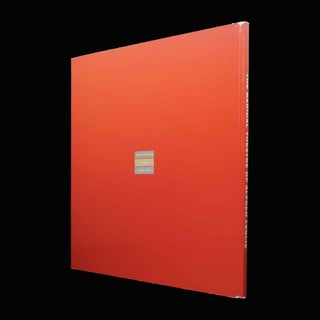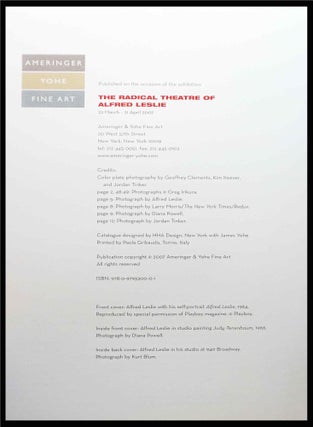The Radical Theatre of Alfred Leslie
Torino, Italy: Ameringer & Yohe Fine Art, 2007. First Edition. Softcover. “An autodidact, independent thinker, and early proponent of interdisciplinary practice, Leslie possesses an aggressive streak of self-reliance that has compelled him throughout his career to challenge himself in startling ways. Offering a unique link between the New York School and postmodernism, his accomplishments provide us with an unorthodox post-war art history lesson, forcing us to reconsider some of our fundamental assumptions about innovation and tradition, the radical and the reactionary.” (Elliott, pg 14). The recently-deceased Alfred Leslie (1927-2023) began his artistic career as an abstract expressionist and shifted towards realism before landing as the original postmodernist in 1969, three years after a devastating fire engulfed his studio and destroyed almost all of his completed and in-progress projects. A painter, a sculptor, a filmmaker, and an experimental innovator, Leslie studied at New York University, the Art Students League, and the Pratt Institute. He made a splash on the scene in 1959 with Pull My Daisy, a short film co-directed by photographer Robert Frank, narrated by Jack Kerouac, and starring Allen Ginsberg (see our items #4822 and #3316). He made several short films after this, such as The Last Clean Shirt with the poet Frank O'Hara in 1964. Leslie is most recognized for his large-scale grisailles, or greyscales, of individual figures, frequently nude, and his frequent use of dramatic lighting. His self-portrait grisaille, one of the few to survive from that era, is on display at the Whitney Museum of American Art. After the fire destroyed his studio, he saw it as an opportunity to adjust course and try something new. He began introducing more color into his portraits, and he expanded his subject matter beyond the individual to scenes and groups, such as “The Killing Cycle” series. His filmmaking perspective influenced his painting, creating a still scene with a narrative and presenting it dramatically to confront the viewer with reality. He also experimented with watercolors and digital media later in his life. A large-format exhibition catalog measuring 10 5/8” long and 9” wide includes the titular essay by David Elliott, a Canadian artist and professor of Painting & Drawing at Concordia University, as well as a writer of reviews, articles, and catalogue essays. The covers both have full-width flaps featuring black-and-white photos of Leslie working in his studio, and a 4”x 6” invitation card is bound within the front cover. The essay itself is 11 pages (pages 3-14) and the remaining 41 pages feature photographs of Leslie and his art (included some that were destroyed) as well as a chronology of his lifetime. The exhibition occurred in Midtown Manhattan next door to The New York Gallery Building from March 22nd, 2007 to April 21st, 2007, and it included works from the thirty-five year period between 1959 and 1995. From the collection of Allen Tobias, assistant to Allen Ginsberg beginning in the 1960s, curator, critical author & scholar who is our good friend & esteemed colleague at the European Beat Studies Network (ebsn.eu). Large format Softcover, First Edition, First (and likely only) Printing, though neither stated as such on copyright page. In Near Fine condition with some minor shelf-wear around the edges of the cover and some scratching on the front and back covers. Pages are pristine. Near Fine. [Item #5428]
Price: $30.00


![[Item #5428] The Radical Theatre of Alfred Leslie. Alfred Leslie, David Elliott.](https://thirdmindbooks.cdn.bibliopolis.com/pictures/5428_1.jpg?width=768&height=1000&fit=bounds&auto=webp&v=1680131784)

